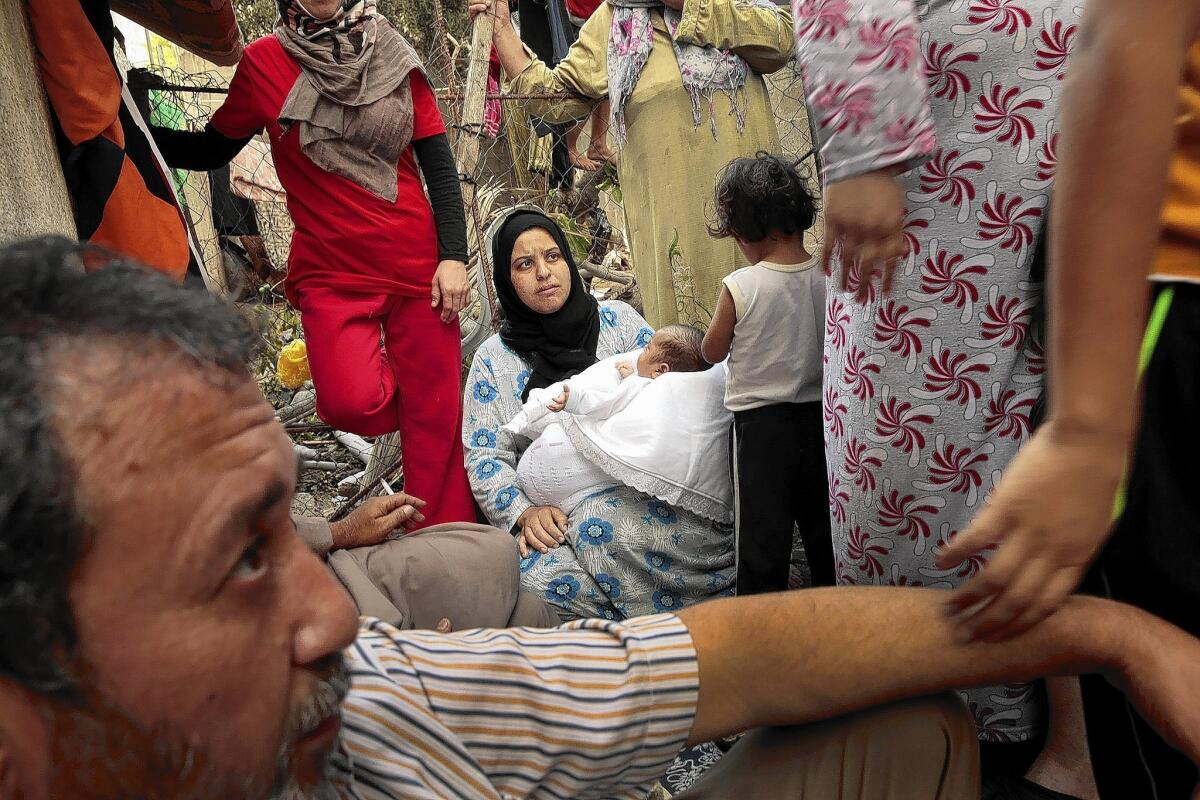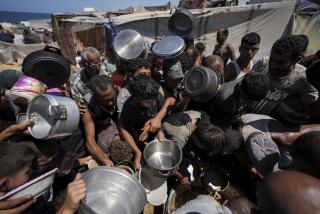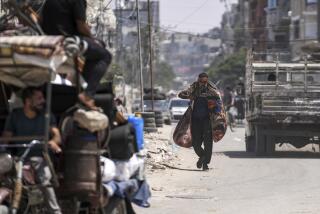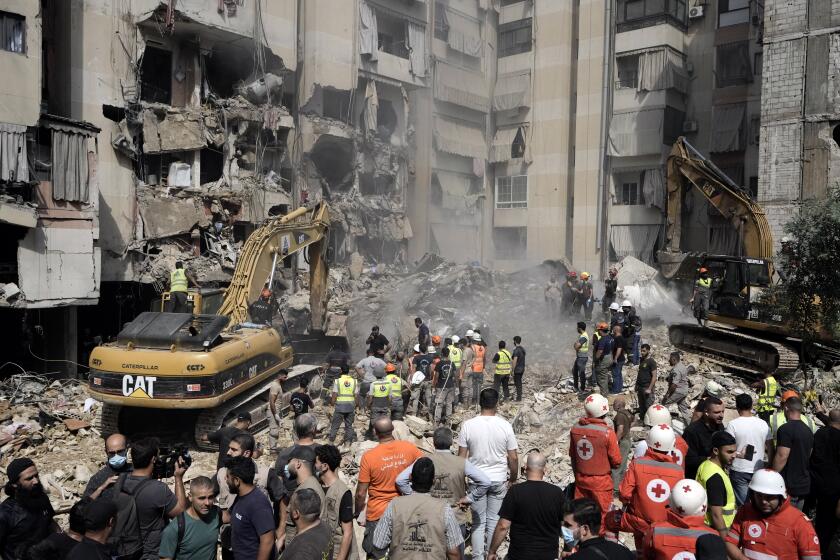About 80 Gaza clan members squeeze into one household

On thin mattresses spread in an open-air courtyard, children slept bunched together as puppies or kittens might. Women bent over a sack of flour, preparing to bake bread on a crude wood stove fashioned from a metal barrel. It was the start of another day of enforced family togetherness — the strain of which was beginning to tell on even a close-knit Palestinian clan.
For most of the last month of fighting between Palestinian militants and Israeli forces, up to 80 people from one extended Palestinian clan, the Abu Amshahs, have sheltered at a relative’s home in central Gaza City. Cultural traditions of hospitality and kinship led their hosts — a wife who hails from the family, and her husband, a Palestinian government worker — to take in dozens of long-term houseguests without question, and for what looked to be an open-ended duration.
The temporary arrivals range in age from 1-month-old Mohammed, gurgling in a plastic car seat, to his 78-year-old great-grandfather, Ahmed. No one could say with precision how many of the houseguests are children; the question prompted a brief debate among adults who ticked off names on their fingers — Aisha, Sami, Abdul, no, you already counted him! Around 50 under the age of 16, the eventual consensus went.
Before the war, the Abu Amshahs lived in six houses in the district of Beit Hanoun in the northern Gaza Strip, which was pounded by Israeli artillery, tank fire and airstrikes in the early days of the fighting. The family fled relatively early on, leaving their homes one morning as shellfire raged around them, taking with them little more than the clothes they were wearing.
They credit that caution with saving their lives. Days later, they learned of friends and neighbors who lay dead in the rubble of their homes.
The Abu Amshahs’ plight serves as a microcosm of the disruption and displacement that will mark Gaza for years to come. At the height of the fighting, an estimated 400,000 people — nearly a quarter of the territory’s population — had been driven from their homes. They took shelter wherever they could find it: in schools designated as U.N. shelters, half a dozen of which were hit by deadly strikes in the course of the warfare; in encampments on the grounds of hospitals and other places considered safe; or on the comfortless concrete slabs of half-constructed high-rise buildings.
Or, in this family’s case, with a relative willing to take them in. All of them.
Some of these stays will be short-term; many not. At least 10,000 houses have been destroyed or damaged too badly to be habitable, according to Palestinian and U.N. estimates. With family size commonly running to a dozen people, that adds up to 100,000 or more who have no home to which to return. War damage in the already impoverished coastal strip runs in the neighborhood of $5 billion, and although the international community has expressed willingness to fund reconstruction, it would have to come in the framework of a so-far-elusive peace accord and could take many years to fulfill.
For the first week of fighting, members of the Abu Amshah family said, there was no electricity, and no fuel to power a generator. Now they have about two hours of power a day, during which they take turns charging cellphones or hurrying to finish tasks. There is one toilet on each floor of the three-story house, including a courtyard privy, and the queue seems ceaseless.
Looking around him, the host, Mohammed Tubeel, a 44-year-old worker with Gaza’s Health Ministry, had only one complaint, and it was a mild one.
“I will miss that fig tree,” he said, gesturing toward a mangled stump. In the early, desperate days when it was too dangerous to leave the walled compound, they chopped it down for firewood.
Tubeel’s wife, Manar, 37, smiled and shook her head when asked how long all these people could remain under their roof.
“It is one day, and then another,” she said. “And then another.”
***
The lack of privacy has proved one of the most difficult challenges of this communal arrangement, the women confided. Almost everyone in the clan is acquainted with one another, but not accustomed to living together in such close quarters.
Women and older girls sleep in a small outbuilding; the men mainly in one basement room and children in another next door, although they tend to wander outside to escape the stifling heat. Because the women are in contact with men who are not immediate family, they wear tight head scarves and long robes at all times. In the heat of the afternoon, they mop their faces, moistening a rag with water from the big plastic tank filled every few days, whenever a tanker truck can make the rounds.
Fitful cease-fires have afforded the opportunity to shop for food, using dwindling pooled funds, but no one strays far from the compound. Too often, short-term truces have deteriorated into fighting, as one did Friday. A new one started at midnight Sunday. No one wanted to be caught away from shelter.
The children, even the smallest, easily distinguish between Israeli aerial bombardment and outgoing rockets fired by Palestinian militants. One afternoon, a pair of Kassam rockets roared directly overhead — fired, apparently, from somewhere close by. Family members appeared only mildly startled at the time, but the next day, one of the men of the family demanded of visitors that no mention be made of the incident.
“You can’t say rockets are coming from anywhere near here!” he declared agitatedly to a visitor. “Do you want Israel to bomb this house and everyone in it?”
***
In Beit Hanoun, the family’s neighborhood, people have a more shellshocked look about them than those in the center of Gaza City, the much safer area where the family is sheltering.
It’s easy to see why.
Together with Shajaiya, east of Gaza City, and Rafah, in the south, it has been one of the hardest-hit districts. All lie close to the border fence with Israel; all were used as staging grounds for Palestinian militants’ attacks, either as sites from which to launch rockets, or as the entry point for tunnels running under the border fence.
A glimpse of one of the family homes on a cease-fire day was no occasion for rejoicing. Rather, it drove home the full proof of the extent of their personal loss. Almost nothing of value could be salvaged, family members said.
“My whole life I worked for my house, and now it is gone,” said a wet-eyed Mohammed Abu Amshah, a 52-year-old merchant and father of 13. His family house was still standing, but punctured in half a dozen places by tank shells. Nearby, a few male relatives debated whether tents could at some point be put up on the patch of open ground, or in the ruined courtyard.
Back at the central city compound, four children clustered on a plastic mat, eating bread and hummus, a mainstay of the house diet. Big sit-down meals were too difficult and impractical, so the children were allowed to eat whenever food was available. But the women mourned the loss of their family meal, the daily glue of their home lives.
“Nothing is the same,” said one. “Our lives are upside down.”
In the shade of the courtyard wall, a few older teenagers were trying to read from salvaged textbooks, absently patting or lightly swatting the children who swarmed around them, shrieking. The universities are closed, but five cousins from the family hoped to start classes when the conflict allowed schools to reopen.
Sirrya, the 73-year-old family matriarch, recalled the family’s exodus at the start of the fighting — nearly 70 years after the turmoil of 1948, when her family first fled its home to the north of Beit Hanoun, in what is now Israel.
“It’s always the same when you run away from your house,” she said. “Just walking, walking, walking. Everyone crying. Every time, we didn’t know where we were going. We just walked.”
As she spoke, she waggled her bare toes. In the panicky rush to flee, she had left her home without shoes. Someone later found her a pair of plastic sandals, but they did not fit well, so she set them aside.
Nearby, the baby Mohammed began to wail. His mother, Reem, moved to tend to him, wincing. The family’s flight came only days after his birth, a difficult one. Another of the women confided in a low voice that Reem was still bleeding and in pain, and needed to see a doctor. So far, she had not felt safe going out.
Lifted from his car seat, swaddled in a sheet and passed from hand to hand, the baby quieted.
“We will raise this child, all of us,” said his great-grandmother. “But then, maybe another war will take him.”
@laurakingLAT
More to Read
Sign up for Essential California
The most important California stories and recommendations in your inbox every morning.
You may occasionally receive promotional content from the Los Angeles Times.










